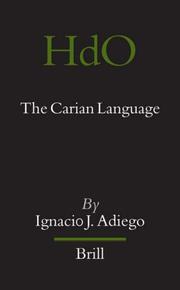| Listing 1 - 2 of 2 |
Sort by
|

ISBN: 9004152814 9789004152816 9786611400217 1281400211 9047410491 9789047410492 9781281400215 6611400214 Year: 2007 Volume: 86 Publisher: Leiden ; Boston : Brill,
Abstract | Keywords | Export | Availability | Bookmark
 Loading...
Loading...Choose an application
- Reference Manager
- EndNote
- RefWorks (Direct export to RefWorks)
This handbook provides a complete and updated view of our current knowledge about Carian, one of the Indo-European languages spoken in ancient Anatolia. The decipherment of the Carian alphabet has only recently made it possible to analyze Carian inscriptions and to classify the Carian language linguistically. The book covers all major topics of research on Carian: the direct and indirect sources with an edition of the Carian inscriptions following a new classification system, the history of the decipherment, the Carian alphabet, and the phonological, morphological, lexical, and syntactic features of the language. It includes an annotated Carian glossary. The volume concludes with a special appendix on Carian coins and legends by Koray Konuk that will be of particular interest to specialists in ancient numismatics.
Carian language. --- Carian language --- Inscriptions, Carian --- Carien (Langue) --- Inscriptions cariennes --- Writing. --- Ecriture --- Writing --- Carian inscriptions --- Anatolian languages --- Inscripties. --- Karisch. --- Écriture. --- Egypte. --- Turkije. --- Carian language - Writing --- Inscriptions, Carian - Egypt --- Inscriptions, Carian - Turkey - Caria
Book
ISBN: 9782356130365 2356130365 235613283X Year: 2010 Publisher: Paris : Pessac : Diffusion de Boccard Ausonius,
Abstract | Keywords | Export | Availability | Bookmark
 Loading...
Loading...Choose an application
- Reference Manager
- EndNote
- RefWorks (Direct export to RefWorks)
Le présent volume procède d'un colloque organisé à Oxford à l'été 2006. Rassemblant linguistes, archéologues, épigraphistes, numismates et historiens, il fut l'occasion d'échanger des idées sur une période de transition fondamentale dans l'histoire de la Carie : le ive siècle et les deux siècles qui suivirent la conquête d'Alexandre. Cette période fut en effet d'abord marquée par la présence et la visibilité des satrapes, mais aussi ensuite par une intense activité civique et une conscience politique accrue des communautés cariennes. La symbiose entre les îles du Dodécanèse, en particulier Rhodes et Cos, et le littoral carien constitue un autre thème important. Plusieurs communications se rattachent enfin à une orientation de recherche sur les cultures anatoliennes qui est aujourd'hui en plein essor, celle de l'étude des interactions culturelles entre Grecs et Anatoliens depuis la fin de l'âge du Bronze et le début de l'âge du Fer, dont on perçoit encore les échos aux époques plus récentes. The conference on which the present volume is based took place in Oxford in the summer of 2006. It brought together linguists, archaologists, epigraphists, numismatists and historians and allowed them to exchange ideas about a period of major transition in Karian history: the fourth century and the two centuries after Alexander. This was first a period of great starapal visibility and presence, but then alsol of intense civic engagement and increased political awareness among Karian communities. The symbiotic relationship between the islands of the Dodekanese, in particular Rhodes and Kos, and the coastal regions of Karia forms another major theme. Finally, a number of papers pick up on a major recent trend in the study of Anatolian culture, namely the investigation of cross-cultural Greeak-Anatolian interactions in the Late Bronze and Early Iron Ages and their echoes in later periods.
Excavations (Archaeology) --- Carian language --- Cities and towns, Ancient --- Fouilles (Archéologie) --- Carien (Langue) --- Villes antiques --- Hecatomnus, --- Caria --- Greece --- Turkey --- Carie (Région ancienne) --- Grèce --- Turquie --- Relations --- Antiquities --- Antiquités --- Carians --- Dodekanesos (Greece) --- Language --- Conferences - Meetings --- Fouilles (Archéologie) --- Carie (Région ancienne) --- Grèce --- Antiquités --- Carie --- Karya --- Antiquities. --- History. --- Language. --- Classical Greek studies --- Classics --- History --- Antiquité grecque --- période hellénistique --- satrapie --- culture anatolienne --- Hellenistic period --- Antiquity --- military campaign --- Hellenistic civilization --- Carie (Turquie ) --- Antiquité
| Listing 1 - 2 of 2 |
Sort by
|

 Search
Search Feedback
Feedback About UniCat
About UniCat  Help
Help News
News